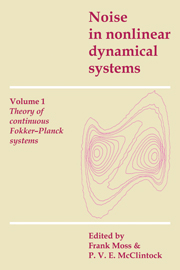Book contents
- Frontmatter
- Contents
- List of contributors
- Preface
- Introduction to Volume 1
- 1 Noise-activated escape from metastable states: an historical view
- 2 Some Markov methods in the theory of stochastic processes in nonlinear dynamical systems
- 3 Langevin equations with colored noise
- 4 First passage time problems for non-Markovian processes
- 5 The projection approach to the Fokker–Planck equation: applications to phenomenological stochastic equations with colored noises
- 6 Methods for solving Fokker–Planck equations with applications to bistable and periodic potentials
- 7 Macroscopic potentials, bifurcations and noise in dissipative systems
- 8 Transition phenomena in multidimensional systems – models of evolution
- 9 Colored noise in continuous dynamical systems: a functional calculus approach
- Appendix: On the statistical treatment of dynamical systems
- Index
8 - Transition phenomena in multidimensional systems – models of evolution
Published online by Cambridge University Press: 05 January 2012
- Frontmatter
- Contents
- List of contributors
- Preface
- Introduction to Volume 1
- 1 Noise-activated escape from metastable states: an historical view
- 2 Some Markov methods in the theory of stochastic processes in nonlinear dynamical systems
- 3 Langevin equations with colored noise
- 4 First passage time problems for non-Markovian processes
- 5 The projection approach to the Fokker–Planck equation: applications to phenomenological stochastic equations with colored noises
- 6 Methods for solving Fokker–Planck equations with applications to bistable and periodic potentials
- 7 Macroscopic potentials, bifurcations and noise in dissipative systems
- 8 Transition phenomena in multidimensional systems – models of evolution
- 9 Colored noise in continuous dynamical systems: a functional calculus approach
- Appendix: On the statistical treatment of dynamical systems
- Index
Summary
Introduction
In this chapter we investigate the influence of noise in systems where many degrees of freedom are participating. The phenomenon we want to investigate is the possibility to leave and to enter attractor regions in bi- and multi-stable systems. It implies the ability to cross through separatrices (to jump over potential barriers) to alternative attractors of the systems after a certain time.
Since the pioneering work of Kramers this phenomenon has been widely investigated in one- and two-dimensional bistable systems (for reviews see Hanggi, 1986, and Weiss, 1986); several papers also appeared on multistable situations (see, e.g., Büttiker and Landauer, 1982). Stochastic transitions in multistable multidimensional systems are of importance for several physical and nonphysical problems, for example for nucleation induced phase transitions, for the molecular dynamics and the kinetics of chemical reactions, for the storage of information in electronic circuits, for learning procedures in networks of bistable elements, for the search of extrema in combinatorial optimization problems, etc. All those problems possess in general many interacting degrees of freedom, have a large number of stable states, configurations, etc.
Though in all the problems mentioned above stochastic transitions between stable states occur, their dynamics may be quite different. In some situations, for example chemical catalysis, it is desirable that the transition takes place very quickly. In other situations transitions should be avoided; for example, computer memory becomes meaningless if transitions occur on time scales which are comparable with the time of calculations.
Information
- Type
- Chapter
- Information
- Noise in Nonlinear Dynamical Systems , pp. 279 - 306Publisher: Cambridge University PressPrint publication year: 1989
Accessibility standard: Unknown
Why this information is here
This section outlines the accessibility features of this content - including support for screen readers, full keyboard navigation and high-contrast display options. This may not be relevant for you.Accessibility Information
- 8
- Cited by
